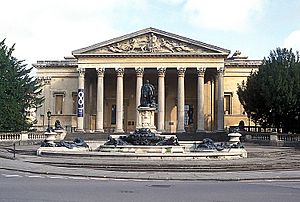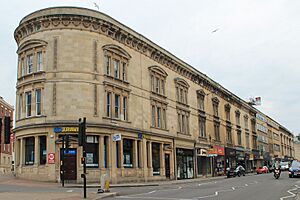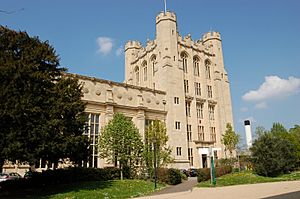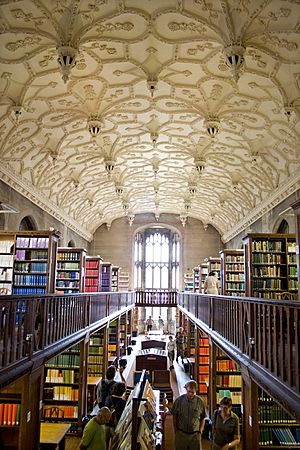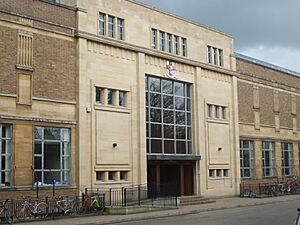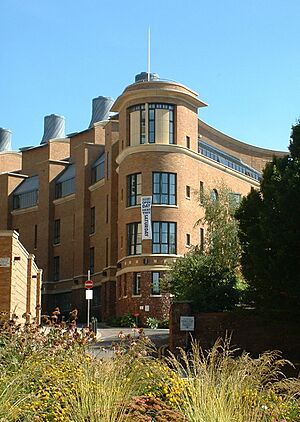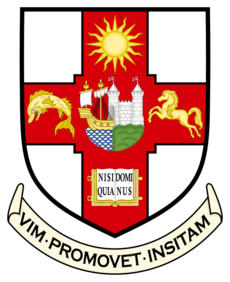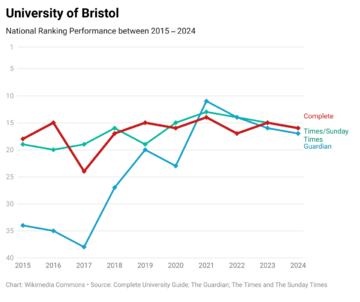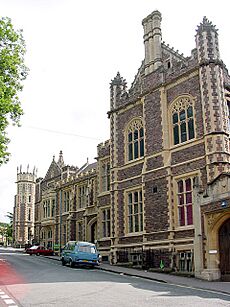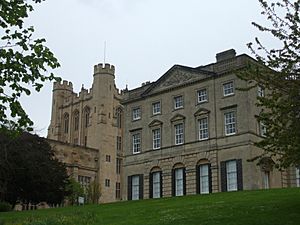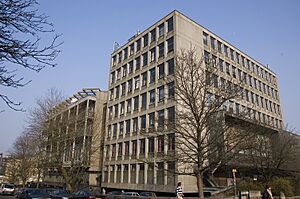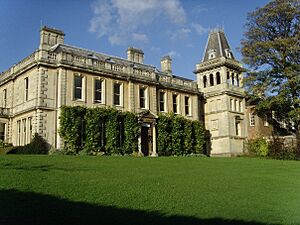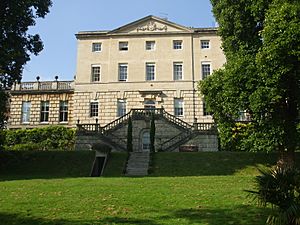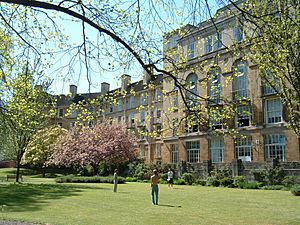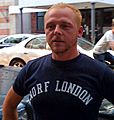University of Bristol facts for kids
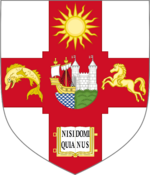
|
|
| Motto | Latin: Vim promovet insitam |
|---|---|
|
Motto in English
|
[Learning] promotes one's innate power (from Horace, Ode 4.4) |
| Type | Public red brick research university |
| Established |
|
| Endowment | £98.7 million (2024) |
| Budget | £1.060 billion (2023/24) |
| Chancellor | Paul Nurse |
| Vice-Chancellor | Evelyn Welch |
| Visitor | Rt Hon. Lucy Powell MP (as Lord President of the Council ex officio) |
|
Academic staff
|
3,770 (2023/24) |
|
Administrative staff
|
5,335 (2023/24) |
| Students | (2015/16) 30,335 FTE (2015/16) |
| Undergraduates | (2015/16) |
| Postgraduates | (2015/16) |
| Location |
,
51°27′23″N 02°36′16″W / 51.45639°N 2.60444°W |
| Campus | Urban |
| Students' Union | University of Bristol Union |
| Colours | Pantone 187 |
| Affiliations |
|
 |
|
The University of Bristol is a well-known public research university located in Bristol, England. It officially became a university in 1909 when it received its royal charter. However, its history goes back much further. It started from a school for Merchant Venturers founded in 1595 and a place called University College, Bristol, which began in 1876. The Bristol Medical School, which started in 1833, joined the University College in 1893 and later became the university's medical school.
The university is organized into six main areas called faculties. These faculties have many schools and departments that offer over 200 different courses for students. Most of these are located in the Tyndall's Park area of the city. In the 2023–24 school year, the university earned over £1 billion. A big part of this money, £294.1 million, came from research projects. The University of Bristol is the largest independent employer in the city of Bristol.
Many important academics work at the university. This includes 23 fellows of the Academy of Medical Sciences and 48 fellows of the Royal Society. The university's former students and teachers also include 13 people who have won the Nobel Prize. Bristol is part of the Russell Group, which is a group of top research universities in the UK. It is also part of the Coimbra Group in Europe and the Worldwide Universities Network. The university sends over 500 students each year to study in Europe through the Erasmus Programme. Many students want to study at Bristol, with about 6 to 13 students applying for every available spot.
Contents
History of the University
The University of Bristol has a long and interesting history.
How the University Started
The very first part of what would become the university was an engineering department. This was part of the Merchant Venturers' Technical College, which started as a school in 1595. The university also grew from the Bristol Medical School, founded in 1833, and University College, Bristol, which opened in 1876. When University College first opened, only 99 students attended the first lecture.
The university was able to get its royal charter (official permission to be a university) because of money from the wealthy Wills and Fry families. These families made their money from tobacco and chocolate. A study in 2018 showed that much of the money used to start the university came from wealth linked to enslaved people. The university received its royal charter in May 1909. In October 1909, 288 undergraduate students and 400 other students joined the new university. Henry Overton Wills III became its first leader, called the chancellor. University College was one of the first places in the country to let women study alongside men. However, women were not allowed to take medical exams until 1906.
Since it officially became a university in 1909, Bristol has grown a lot. It is now one of the biggest employers in the area.
Early Years and Growth
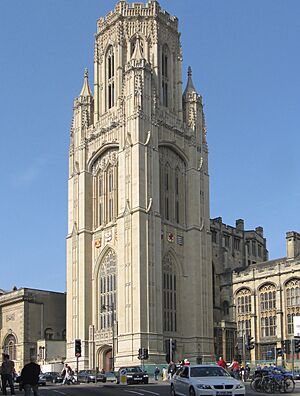
After University College started in 1876, the government began to support it financially in 1889. More money came from joining with the Bristol Medical School in 1893 and the Merchant Venturers' Technical College in 1909. This allowed new medical and engineering schools to open. These subjects are still very strong at the university today.
In 1908, the Fry and Wills families gave large donations, including £100,000 from Henry Overton Wills III. This money was meant to create a university for Bristol and the West of England. The only condition was that an official royal charter had to be obtained within two years. In December 1909, the king granted the charter, and the University of Bristol was officially created. Henry Wills became its first chancellor, and Conwy Lloyd Morgan was the first vice-chancellor. Henry Wills passed away in 1911. To honor him, his sons, George and Harry, built the Wills Memorial Building. Construction started in 1913 and finished in 1925. Today, this building is home to parts of the earth sciences and law departments. Graduation ceremonies are also held in its Great Hall. The Wills Memorial Building is a very important historic building.
In 1920, George Wills bought the Victoria Rooms and gave them to the university to be used as a students' union. This building now houses the Department of Music and is also a very important historic building.
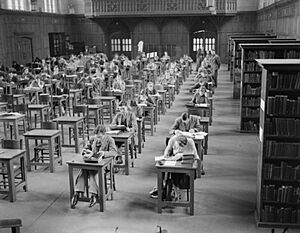
When the university was founded, it was expected to help the local community. This led to the creation of the Department of Extra-Mural Adult Education in 1924. This department offered courses to people in the local area. This idea continues today, with a special admissions policy for students from the "BS" postcode area of Bristol.
One famous person linked to Bristol from this early time is Paul Dirac. He finished his engineering degree in 1921 and then a second degree in mathematics in 1923. He later won the 1933 Nobel Prize in Physics for his important work on quantum mechanics. In the late 1920s, the H. H. Wills Physics Laboratory was opened by Ernest Rutherford. This lab has been home to several other Nobel Prize winners: Cecil Frank Powell (1950), Hans Albrecht Bethe (1967), and Nevill Francis Mott (1977). The laboratory is still in the same place today, near the Bristol Grammar School and the city museum.
Winston Churchill became the university's third chancellor in 1929 and served until 1965. He took over from Richard Haldane, who had been chancellor since 1912.
During World War II, the Wills Memorial Building was bombed. The Great Hall and its organ were destroyed, along with 7,000 books that had been moved there from King's College London for safety. The building has since been repaired and now has oak walls and a new organ.
After the War
In 1946, the university started the first drama department in the country. In the same year, Bristol began offering special entrance exams and grants to help soldiers returning home from the war. The number of students kept growing. The Faculty of Engineering needed a new building, which became the Queen's Building in 1955. This large building housed all of the university's engineers until 1996. At that time, the electrical engineering and computer science departments moved to the new Merchant Venturers' Building. This made space for these fast-growing fields. Today, the Queen's Building is used for most of the teaching for "heavy" engineering subjects like civil, mechanical, and aerospace.
As student numbers grew a lot in the 1960s, the Students' Union needed a bigger place. They moved to a new building in the Clifton area of the city in 1965. This building was much larger than the Victoria Rooms, which then became home to the Department of Music. The University of Bristol Union building has many rooms for practice and performances, plus three bars. While it is large, some people think the Union building looks out of place compared to the older buildings in Clifton. The university has suggested moving the Union to a more central location in the future.
The 1960s were a time when many students in the UK protested, and Bristol was no different. In 1968, many students marched to support the Anderson Report, which asked for more money for students. This led to an 11-day sit-in at the Senate House, which is the university's main office building. Several chancellors and vice-chancellors led the university during these years. Henry Somerset, 10th Duke of Beaufort became chancellor after Churchill in 1965. He was then followed by Dorothy Hodgkin in 1970, who held the position for 18 years.
As more and more people went to university, Bristol kept increasing its student numbers. The student living places were expanded many times. More recently, some living places for postgraduate students have been built. These newer places are funded and run by outside companies that work with the university.
One of the few centers for deaf studies in the UK was started in Bristol in 1981. In 1988, the Norah Fry Centre for research into learning difficulties was also established. Also in 1988, and again in 2004, students voted to leave the National Union of Students (NUS). However, both times, a vote by all students later reversed that decision, so Bristol is still part of the NUS.
In 1988, Sir Jeremy Morse, who was the chairman of Lloyds Bank, became chancellor.
The 21st Century
As the number of postgraduate students grew, especially those studying for master's degrees, there was a need for them to have their own representation. So, the Postgraduate Union (PGU) was created in 2000. Universities are now expected to use the new ideas and inventions that come from their research. In 2000, Bristol started the Research and Enterprise Division (RED) to help with this, especially for technology businesses. In 2001, the university signed a 25-year deal for research funding with IP2IPO, a company that helps turn ideas into businesses. In 2007, research activities grew even more with the opening of the Advanced Composites Centre for Innovation and Science (ACCIS) and The Bristol Institute for Public Affairs (BIPA).
In 2002, the university was involved in a discussion about news reporters getting too much information. This happened after details about then-prime minister Tony Blair's son's university application were printed in newspapers. In the same year, the university opened a new Centre for Sports, Exercise and Health in the middle of the university area. Local residents can also use these facilities for a fee.

Brenda Hale, the first female Law Lord, became chancellor of the university in 2003. Sir Paul Nurse took over from Lady Hale as chancellor on January 1, 2017.
Teaching and research continue to expand. In 2004, the Faculty of Engineering finished building the Bristol Laboratory for Advanced Dynamics Engineering (BLADE). This £18.5 million project is meant to help study dynamics further and is the most advanced facility of its kind in Europe. It was built as an addition to the Queen's Building and was officially opened by Queen Elizabeth II in March 2005.
In January 2005, the School of Chemistry received £4.5 million to create Bristol ChemLabS. This is a Centre for Excellence in Teaching & Learning (CETL) and is the only chemistry CETL in the UK.
September 2009 saw the opening of the university's Centre for Nanoscience and Quantum Information. This £11 million building is known as one of the quietest buildings in the world and has other advanced features like self-cleaning glass. Important research into quantum computing, nanotechnology, and other subjects is done in this building.
There are also plans to greatly improve the center of the university area in the coming years. The first step began in September 2011, with the start of building a very modern Life Sciences building.
In 2018, while construction was happening in the Fry Building, the building caught fire.
In 2024, the university changed its emblem. They removed the dolphin symbol because of its connection to the slave trader Edward Colston. They added a new image of moving pages and a bookmark instead.
In 2025, BristolSEDS, a student group at the university, successfully tested a powerful rocket engine. It set a record for the highest thrust from a student-designed engine of its type in the UK.
University Campus
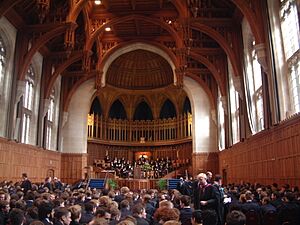
Buildings and Locations
The University of Bristol does not have one main campus. Instead, its buildings are spread out over a large area. However, most of its activities are in the city center, in an area called the "University Precinct."
Some of the university's buildings are very old, dating back to before it officially became a university. These buildings were designed by Charles Hansom. The first big building project after the university received its charter was the Wills Memorial Building. The windows in this building show symbols of the Wills and Fry families, who helped found the university. Other important buildings include Royal Fort House, the University of Bristol Botanic Garden, and many large Victorian houses that were changed for teaching in the Faculty of Arts. The Victoria Rooms, which house the Music Department, were designed by Charles Dyer.
Goldney gardens became part of the university through George Alfred Wills. He had hoped to build a living place for only male students there. However, this was stopped because the head of Clifton Hill House objected to male and female student homes being so close. University records show that Miss Starvey was ready to resign over this issue. Eventually, land was bought in Stoke Bishop, which allowed for the building of Wills Hall. This hall was designed to look like the colleges at Oxford and Cambridge. After George Wills died, his widow added the Dame Monica Wills Chapel. When Goldney did become student housing in 1956, the apartments were designed by Michael Grice, who won an award for his work.
Burwalls, a large house across the Avon Gorge, used to be a student living place. It was also once the home of Sir George Oatley. The building is now used for the Centre for Continuing Education.
Many of the newer buildings, like Senate House and parts of the HH Wills Physics Laboratory, were designed by Ralph Brentnall. He also designed the addition to the Wills Memorial Building library. It was built so well that many people don't realize it's an extension to the original building.
In May 2022, the university announced the opening of the Gambling Harms and Research Centre (GHRC). This £4 million center aims to help people understand the issues related to gambling. The project was funded by the GambleAware charity. They chose the university because of its history of researching gambling topics.
Future Plans
In November 2016, the university announced plans to build a new £300 million Temple Quarter Campus. This campus will be for about 5,000 students and will be next to Bristol Temple Meads railway station. The new campus will include a business school, digital research facilities, and a student village. It is expected to open in 2021. For the existing campus, there are plans to change Tyndall Avenue, make the surrounding area pedestrian-friendly, and build a new library.
How the University is Organized
Like most universities in the UK, Bristol is officially led by the chancellor, who is currently Sir Paul Nurse. The day-to-day running of the university is handled by the vice-chancellor, Professor Evelyn Welch, who is the academic leader and chief executive. There are also four pro vice-chancellors and three ceremonial pro-chancellors. The chancellor can hold office for up to ten years. The vice-chancellor is supported by a deputy vice-chancellor.
The university is made up of several schools and departments, organized into six main faculties:
Faculty of Arts
- School of Arts
- Anthropology and Archaeology
- Film and Television
- Music
- Philosophy
- Theatre (also see the University of Bristol Theatre Collection)
- School of Humanities
- Classics and Ancient History
- English
- History
- History of Art
- Religion and Theology
- School of Modern Languages
- French
- German
- Hispanic, Portuguese and Latin American Studies
- Italian
- Russian
- Centre for English Language and Foundation Studies
- Centre for Innovation
Faculty of Engineering
- School of Computer Science, Electrical and Electronic Engineering, and Engineering Mathematics
- Computer Science
- Electrical & Electronic Engineering
- Engineering Mathematics
- School of Civil, Aerospace and Mechanical Engineering
- Aerospace Engineering
- Civil Engineering
- Mechanical Engineering
- Engineering Design
- Engineering with Management
Faculty of Life Sciences
- School of Biological Sciences
- School of Biochemistry
- School of Cellular and Molecular Medicine
- School of Physiology, Pharmacology and Neuroscience
- School of Psychological Science
Faculty of Science
- School of Chemistry
- School of Earth Sciences
- School of Geographical Sciences
- School of Mathematics
- School of Physics
- Centre for Device Thermography and Reliability
- Centre for Nanoscience & Quantum Information
- Interface Analysis Centre
Faculty of Health Sciences
- Bristol Dental School
- Bristol Medical School
- Population Health Sciences
- Public Health
- Digital Health
- Translational Health Sciences
- Population Health Sciences
- Bristol Veterinary School
- Centre for Health Sciences Education
- Centre for Applied Anatomy
- Master's in Teaching and Learning for Health Professionals
Faculty of Social Sciences and Law
- School of Education
- School for Policy Studies
- School of Economics
- Centre for Market and Public Organisation
- School of Sociology, Politics and International Studies
- University of Bristol Business School
- University of Bristol Law School
Academic Dress
The university has its own special robes and hoods, called academic dress, that students and staff wear for formal events like graduation. They use a mix of styles from Cambridge and Oxford universities. Most of the gowns are Oxford-style, and the hoods are Cambridge-style. They are all a special 'university red' color.
University Finances
In the financial year ending July 31, 2024, Bristol had a total income of £1.060 billion. Its total spending was £768.7 million. Key sources of income included £459.9 million from tuition fees and education contracts, and £294.1 million from research grants.
At the end of the year, Bristol had special funds called endowments worth £98.7 million. It also had total net assets of £1.581 billion. The university has the fifteenth-largest endowment of any university in the UK.
Logo and Coat of Arms
In 2004, the university introduced a new logo. The symbols in the logo represent different things:
- The sun is for the Wills family.
- The horse is for the Fry family.
- The ship-and-castle comes from the old seal of the City of Bristol.
- The dolphin symbol, which was connected to Edward Colston, was removed in 2024.
The overall shape of the logo looks like an open book, symbolizing learning. This new logo is used for most things, but the older university arms (a special shield design) are still used for historical or ceremonial events.
The university's motto, written in Latin, is Vim promovet insitam. This means '[Learning] promotes one's innate power'.
Academics and Admissions
How to Get In
|
| Domicile and Ethnicity | Total | ||
|---|---|---|---|
| British White | 52% |
|
|
| British Ethnic Minorities | 16% |
|
|
| International EU | 3% |
|
|
| International Non-EU | 30% |
|
|
| Undergraduate Widening Participation Indicators | |||
| Female | 55% |
|
|
| Independent School | 25% |
|
|
| Low Participation Areas | 7% |
|
|
Bristol is a popular university, and it can be hard to get in. In 2015, it had the 8th highest average entry qualifications for new students in the UK. This means students needed very good grades to get accepted. In 2022, the university offered admission to 52.2% of its undergraduate applicants.
According to a 2017 guide, about 40% of Bristol's undergraduate students came from independent (private) schools. In the 2016–17 school year, about 78% of students were from the UK, 5% from the EU, and 17% from outside the EU. The student body was 55% female and 45% male.
Rankings and Reputation
| National rankings | |
|---|---|
| Complete (2021) | 15 |
| Guardian (2021) | 16 |
| Times / Sunday Times (2021) | 11 |
| Global rankings | |
| ARWU (2020) | 97 |
| QS (2021) |
51 |
| THE (2021) | 78 |
| British Government assessment | |
| Teaching Excellence Framework | Silver |
The University of Bristol is highly ranked for its research quality. It is ranked number 5 in the UK for research. Subjects like Chemistry (1st), Physics (5th), Engineering (6th), and Law (3rd) are especially well-regarded. The Complete University Guide 2024 ranks Bristol 4th for the quality of its research. Bristol is also ranked 5th for the number of new companies started from its research.
The University of Bristol is one of the most popular universities for top employers in the UK. It was ranked joint 7th in the UK for how well its graduates find jobs.
Around the world, the 2024 QS World University Rankings placed Bristol at 55th overall and 9th in the UK. The Times Higher Education World University Ranking placed Bristol at 76th globally and 9th in the UK in 2023. Another international ranking, the Academic Ranking of World Universities, placed Bristol 88th globally and 8th in the UK in 2023.
Degrees Offered
Bristol offers many different academic degrees, including bachelor's and master's degrees. They also offer special doctorates. The names of the degrees are similar to those used at other British universities. The university is part of the Engineering Doctorate program, offering degrees in systems engineering, engineering management, aerospace engineering, and non-destructive evaluation.
Bristol does not award bachelor's degrees in music with the title "Bachelor of Music," but students can study music and receive a BA degree. They also do not offer degrees in divinity.
Publishing and Business Activities
Bristol University Press
Bristol University Press is a publishing company based at the University of Bristol. In 1996, the university started Policy Press, which published academic books in social sciences. In October 2016, Policy Press became part of the new Bristol University Press.
This university press is a non-profit organization. It publishes 22 journals and 200 books each year on subjects like Ageing, Business, Criminology, Economics, Environment, Law, Politics, and Sociology.
Bristol is Open
Bristol is Open, or BiO, was a project between Bristol City Council and the University of Bristol. It aimed to help develop Bristol as a "Smart City" and create a special network for digital experiments. This partnership started in April 2015 and ended in December 2019, with Bristol City Council taking full control. The project completed many technical tests, including providing open Wi-Fi to help reduce the digital divide.
Student Life
Students' Union
The University of Bristol Students' Union (Bristol SU) is located in the Richmond Building on Queen's Road. It is one of the oldest students' unions in England and was a founding member of the National Union of Students. The union runs three student media groups: UBTV (a TV station), the Bristol University Radio Station (BURST), and the student newspaper Epigram.
The Union helps students by representing their academic interests. It also organizes the yearly Welcome Fair, coordinates volunteering projects in the local community, and arranges fun events. There are over 400 student groups, societies, and clubs. Famous past presidents include Sue Lawley and former politician Lembit Öpik. There is a separate union for postgraduate students and an athletic union for sports. For excellent sports achievements, Bristol's athletes are awarded "reds."
Student Living Places
Student accommodation is mainly in the central university area and two other parts of Bristol: Clifton and Stoke Bishop. These are known as the West and North Villages.
In Stoke Bishop, Wills Hall was the first to open in 1929, opened by then-chancellor Winston Churchill. It has been expanded twice. Churchill Hall, named after the chancellor, opened in 1956, followed by Badock Hall in 1964. Hiatt Baker Hall is now the largest hall at the university. The first self-catering hall in Stoke Bishop was University Hall, opened in 1971.
In Clifton, Goldney Hall was built in the early 1700s by the wealthy Goldney family. It became part of the university in 1956. It's a popular place for filming movies and TV shows, like The Chronicles of Narnia and Only Fools and Horses. The Grotto in its gardens is a very important historic building. Clifton Hill House is another important historic building used for student accommodation in Clifton. It was built between 1745 and 1750 and has been used by the university since 1909. Manor Hall includes five separate buildings. One of its parts, Manor House, was recently renovated in 1999.
In the central university area is The Hawthorns, which houses 115 undergraduate students. It started as a group of villas built between 1888 and 1924 and was later turned into a hotel. The Hawthorns also has meeting facilities and offices. 33 Colston Street opened in the city center in October 2011.
Several newer student living places in the central area are built and managed by other companies that work with the university. These include New Bridewell House (opened 2016), Unite House (2000), Chantry Court (2003), Dean's Court (2001, for postgraduates only), and Woodland Court (2005).
All the main halls have student groups called Junior Common Rooms. These groups organize social events for the students living there. Students living in other types of accommodation become members of Orbital, a society that organizes social events throughout the year.
Sports at Bristol
About 4,000 students at Bristol University are involved in sports. The university has over 70 sports clubs and four sports locations. These are run by the university's Student Union and its Sport, Exercise and Health Department. Bristol University competes with other universities in the British Universities and Colleges Sport league (BUCS) and is ranked 8th in the country.
The university has sports facilities at four main places:
Bristol University Indoor Sports Centre- This center is in the middle of the university campus. It has a two-story gym, fitness studios, a sports hall, and a Sports Medicine Clinic.
Coombe Dingle Sports Complex- This large 38-acre site is in Stoke Bishop. It has the only indoor tennis center in Bristol and is where many outdoor sports are played. Coombe Dingle is used for training and competitions throughout the year.
Facilities at Coombe Dingle Sports Complex include:
- 3G pitch (a type of artificial grass field)
- Artificial pitches (sand-covered and with lights)
- Grass pitches for football and rugby
- Cricket areas and nets
- Indoor and outdoor tennis courts (with lights)
- Lacrosse pitch
- Outdoor netball courts
- Olympic weight lifting gym
- Softball and rounders facilities
- A building with a lounge bar and meeting rooms
- A Sports Medicine Clinic
Richmond Building- The university swimming pool is inside the student union building. This pool has six lanes and can be adjusted for competitions. It also has a smaller pool for lessons. Students, staff, and the community can use the pool for swimming or lessons.
Saltford Boathouse- The University Boathouse is located at Saltford, on the River Avon. It is used for rowing and sailing training and competitions during term time.
Notable People from Bristol
Famous Academics
Current academics at the University of Bristol include many important researchers. There are 23 fellows of the Academy of Medical Sciences, 13 fellows of the British Academy, and 48 fellows of the Royal Society. These include Sir Michael Berry, who helped discover the "geometric phase" in quantum mechanics. Also, John Rarity, an expert in quantum optics and quantum cryptography, and David May, a computer scientist known for the transputer. Other notable academics include Mark Horton, an archaeologist, and Bruce Hood, a leading psychologist.
Computer science academics include David Cliff, who invented the "ZIP" trading algorithm, and Nigel Smart. In engineering, there is materials scientist Stephen Eichhorn.
Past academics at the university include Patricia Broadfoot, who was a vice-chancellor at another university, and Nigel Thrift, a vice-chancellor of the University of Warwick. Anthony Epstein, who helped discover the Epstein-Barr virus, was a professor here. Alfred Marshall, an important economist, was also a principal at University College.
The University of Bristol is linked to three Ig Nobel Prizes. These are awards for unusual or funny scientific achievements. Sir Michael Berry won one for using magnets to make a frog float. Gareth Jones also won an Ig Nobel prize for studying fruit bats. Dr. Len Fisher won a prize for figuring out the best way to dunk a biscuit.
Famous Alumni
- Notable Bristol alumni include:
-
James Blunt, musician
-
Paul Dirac, physicist
-
Jonathan Evans, former head of MI5
-
Hun Manet, Prime Minister of Cambodia
-
Simon Pegg, actor and writer
-
Susanna Reid, TV journalist
-
David Walliams, comedian
Bristol alumnus Paul Dirac won the Nobel Prize in Physics in 1933 for his work on quantum mechanics. He is considered one of the most important physicists of the 20th century. Other famous scientists include Dani Rabaiotti, an environmental scientist, and Eliahu Nissim, a professor of aeronautical engineering.
Many writers have studied at Bristol, including Dick King-Smith, Angela Carter, Julia Donaldson, and David Nicholls. His novel Starter for Ten is set at the University of Bristol.
In government and politics, notable alumni include Albert II, Prince of Monaco and Prime Minister Hun Manet of Cambodia. Also, Sir Jonathan Evans, former head of MI5, and Paul Boateng, the UK's first Black Cabinet Minister.
In news and media, former students include journalist Misha Glenny, BBC News reporter James Landale, and editor-in-chief of The Telegraph Media Group William Lewis. Radio 4 presenter Sue Lawley and newsreader Alastair Stewart also studied here. BBC Breakfast and Good Morning Britain anchor Susanna Reid was an editor of the student newspaper Epigram.
In entertainment, former students include singer James Blunt, illusionist Derren Brown, and comedians Jon Richardson, Marcus Brigstocke, Matt Lucas, and David Walliams. Actors Simon Pegg and Pearl Mackie also studied here.
Other alumni include Anne McClain, a NASA Astronaut, and long jumper Jazmin Sawyers.
Images for kids
See also
 In Spanish: Universidad de Bristol para niños
In Spanish: Universidad de Bristol para niños
- Armorial of British universities
- CHOMBEC
- Education in Bristol
- List of modern universities in Europe (1801–1945)
- List of universities in the United Kingdom
- University of Bristol Theatre Collection


